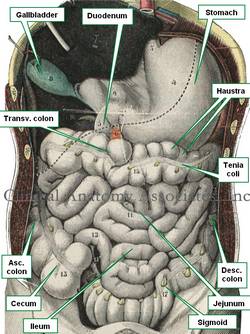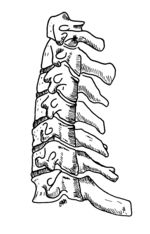Terminal ileum, cecum,
and vermiform appendix
The [mesoappendix] is a triangular-shaped double-layered peritoneal membrane related to the vermiform appendix. One of the sides attaches to the vermiform appendix, the other is free, and the third one attaches to the ileum and the cecum. This last attachment varies in extension, giving the cecum varying degrees of mobility.
The mesoappendix contains the appendicular artery. This artery arises either from the ileocolic artery or the from the posterior ileocecal artery. The mesoappendix also contains the appendicular veins, lymphatics, lymphatic nodes, and fat.
In the female, there can be an extension of the mesoappendix that communicates with the broad ligament of the uterus. It is called the appendiculoovarian ligament, or Clado's ligament. This ligament may contain the appendiculoovarian artery, an anastomosis between the appendicular artery and the ovarian artery. The lymphatics contained in this appendiculoovarian ligament can also establish a lymphatic communication between the ovary and the vermiform appendix.
Sources:
1 "Tratado de Anatomia Humana" Testut et Latarjet 8 Ed. 1931 Salvat Editores, Spain
2. "Anatomy of the Human Body" Henry Gray 1918. Philadelphia: Lea & Febiger Image modified by CAA, Inc. Original image by Henry Vandyke Carter, MD., courtesy of bartleby.com







